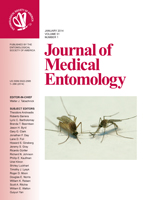For many insect species, group living provides physiological and behavioral benefits, including faster development. Bed bugs (Cimex lectularius L.) live in aggregations composed of eggs, nymphs, and adults of various ages. Our aim was to determine whether bed bug nymphs reared in groups develop faster than solitary nymphs. We reared first instars either in isolation or in groups from hatching to adult emergence and recorded their development time. In addition, we investigated the effects of group housing on same-age nymphs versus nymphs reared with adults. Nymphal development was 2.2 d faster in grouped nymphs than in solitary-housed nymphs, representing 7.3% faster overall development. However, this grouping effect did not appear to be influenced by group composition. Thus, similar to other gregarious insect species, nymph development in bed bugs is faster in aggregations than in isolation.
How to translate text using browser tools
1 January 2014
Group Living Accelerates Bed Bug (Hemiptera: Cimicidae) Development
Virna L. Saenz,
Richard G. Santangelo,
Edward L. Vargo,
Coby Schal
ACCESS THE FULL ARTICLE
It is not available for individual sale.
This article is only available to subscribers.
It is not available for individual sale.
It is not available for individual sale.
<
Previous Article
|

Journal of Medical Entomology
Vol. 51 • No. 1
January 2014
Vol. 51 • No. 1
January 2014
aggregation
bed bug
Cimicidae
development
social interaction




